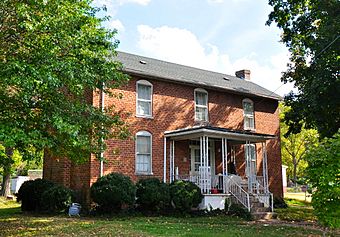Pompey Callaway House facts for kids
|
Pompey Callaway House
|
|

Pompey Callaway House, October 2013
|
|
| Location | VA 754, 0.2 miles (0.32 km) east of US 460, near Elliston, Virginia |
|---|---|
| Area | less than one acre |
| Built | c. 1910 |
| Built by | Callaway, Pompey |
| Architectural style | Single-pile center-passage |
| MPS | Montgomery County MPS |
| NRHP reference No. | 89001811 |
Quick facts for kids Significant dates |
|
| Added to NRHP | November 13, 1989 |
The Pompey Callaway House is a historic home located near Elliston, Virginia. This special house tells an important story about American history. It was built around 1910 and is a two-story brick building. The house was once the home of Pompey Callaway, who built it himself.
Contents
A Special Home with History
The Pompey Callaway House is a two-story brick building. It has a design called a "central passage plan." This means there is a hallway right in the middle of the house. Rooms are located on either side of this central hallway. The house is an important example of homes built during that time.
Who Was Pompey Callaway?
Pompey Callaway was a very important person in the history of this house. He was a formerly enslaved person from Franklin County, Virginia. After slavery ended, he worked hard to build a life for himself and his family. Building this house was a big achievement for him.
Why This House Is Special
The Pompey Callaway House is one of the most important homes built by an African-American owner in Montgomery County, Virginia before 1920. At that time, it was not common for African Americans to own such a large and well-built home. This house shows Pompey Callaway's success and determination. It stands as a symbol of strength and progress.
Protecting History: The National Register
Because of its importance, the Pompey Callaway House was added to the National Register of Historic Places in 1989. The National Register is a list of places in the United States that are important to history. Being on this list helps protect the house. It makes sure future generations can learn from its story.



